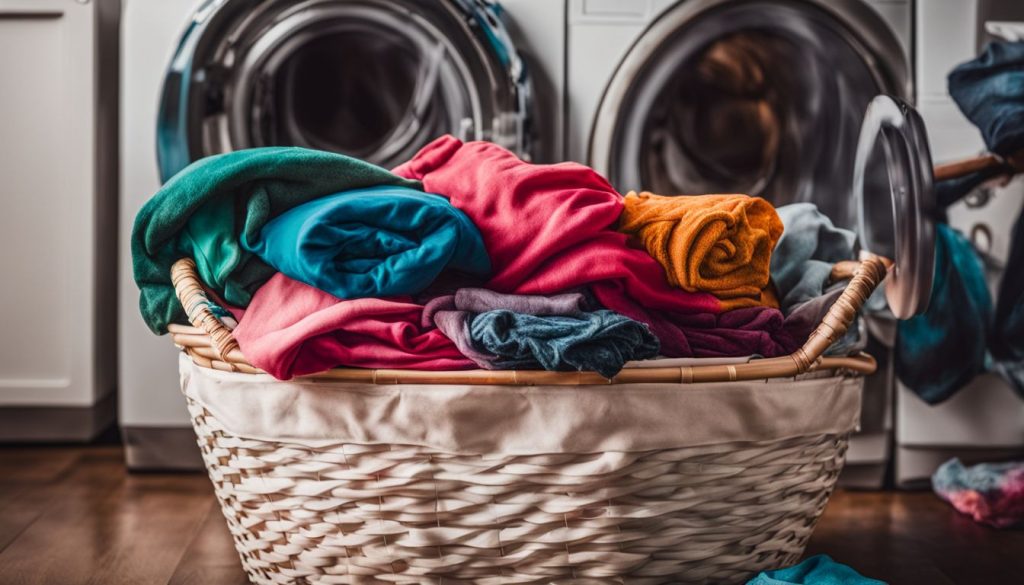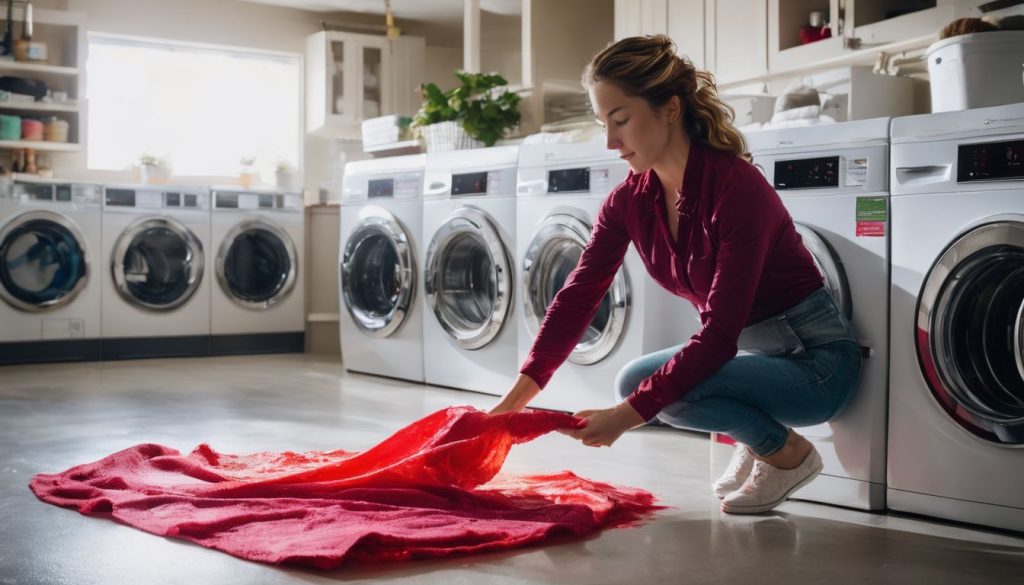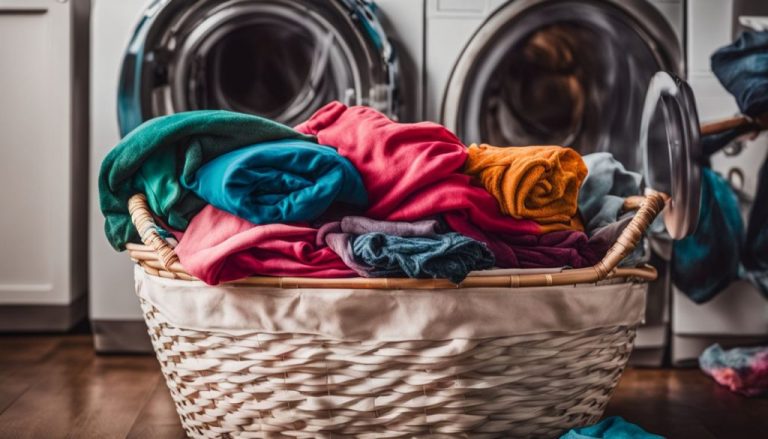Don’t let your wardrobe fall victim to the dreaded color bleed! With the right techniques and a bit of know-how, you can keep your clothes looking as vibrant as ever. For more tips on maintaining your fashion favorites, visit inktasticmerch.com and explore a world of colorful possibilities.
Witnessing a cascade of colors emerge from your laundry can be a deeply unsettling experience. Color bleeding can transform the simplicity of washing clothes into a daunting challenge, threatening to ruin beloved pieces.
This article presents effective strategies and time-tested remedies to halt color bleeding, restoring your outfits to their pristine condition. Continue reading for a comprehensive recovery plan.
Key Takeaways
- Rapidly address color bleed stains to prevent them from embedding in fabrics, using cold water to rinse immediately.
- To combat color bleed, steer clear of dryers which can lock stains in place; opt for soaking items in laundry detergent, vinegar, or oxygenated bleach depending on the fabric and dye’s resilience.
- If white garments suffer from color bleed, hydrogen peroxide serves as both a brightener and a gentle bleaching alternative to remove unwanted dye.
- Avoid future color bleed mishaps by sorting laundry correctly, using color catchers during wash cycles, and pre-washing new clothes before mixing them with other laundry.
- After treating for color bleed, air-dry clothes flat or on a rack away from sunlight, iron with appropriate settings using a pressing cloth, and store garments soundly to keep them in top condition.
Understanding Color Bleed

Recognizing color bleed starts with identifying the incident—an inexplicably vivid item turns the water into a kaleidoscope, and suddenly, your laundry bears unexpected shades.
Prompt action is essential, as newly bled colors can be more easily removed before they anchor into your cherished fabrics.
How Color Bleeds Happen
Color bleeds occur when dyes from one garment leach into another during laundry. This happens more readily in hot water, which loosens dye’s hold on fibers, allowing it to blend with neighboring garments.
Clothes lacking colorfastness are particularly vulnerable, as they tend to release colors in the wash. This could mean your vibrant red sock might turn your white T-shirts a rosy pink.
Reducing the risk of bleeding involves sorting laundry by color and appropriate washing temperatures. Reds should remain with reds, blues with blues, especially in cold water cycles to safeguard against dye loss.
Color-catcher sheets are a wardrobe ally, catching stray dyes before they can cause havoc on other fabrics. New clothes should be separated until their colorfastness is confirmed, as they are often the culprits behind surprising color runs.
The Importance of Treating it Immediately
Swift action in addressing fabric color bleeds is indispensable. Once dyes transfer between garments, they start to embed into fibers. Delaying treatment makes removal harder, risking permanent damage to your clothes’ pristine appearance.
Cold water acts as an initial shield, preventing dye molecules from bonding with fabrics, thus increasing the likelihood of stain removal.
Immediate intervention also safeguards the durability and look of clothing by preserving fabric integrity and color retention. Laundry guidelines often stress the need for prompt action on discoloration to maintain fabric quality.
AfterProper laundry practices, such as sorting garments and using color catchers, can prevent future color bleeding incidents. Moving forward, let’s explore effective methods for removing stubborn stains.
How to Remove Color Bleed from Clothes

If color bleed tarnishes your favorite clothes, there’s no need for despair. Discovering the right techniques and household remedies will renew your garments to their vibrant glory without cementing those stains permanently.
Avoid Putting Clothes in the Dryer
When dealing with color bleed, avoiding the dryer is essential. Heat can set stains, locking unwanted dye into the fibers, making restoration significantly harder.
Opt for air drying these items until the issue is completely resolved.
Handle wet, color-bleeding garments with care by laying them flat or hanging them to dry. This gentle approach avoids fabric stress that tumbling in a hot dryer could cause.
Additionally, fresh air and time will provide a conducive setting for effective stain removal later.
Prepare a Laundry Detergent Solution and Soak
Staying away from the dryer is vital, but advancing with stain treatment is just as important. Once you remove the clothes from the wash, the next step is to address the color bleed head-on.
- Select a gentle laundry detergent suitable for the affected fabric type.
- Fill a sink or bucket with cold water, ensuring there’s ample room to fully submerge the stained garments.
- Mix in half a cup of laundry detergent to form a consistent, soapy solution.
- Immerse the color-stained clothes in the mixture and let them soak. Light stains might require 30 minutes, while heavier ones could need several hours.
- Occasionally agitate the water to help detach the fugitive dyes from the fabric.
- Monitor the soaking items to prevent color transfer between them.
- If stains persist after soaking, consider a stronger treatment like oxygen bleach or vinegar.
- Rinse thoroughly with cold water until all soap suds are eliminated.
Use Vinegar or Oxygen-Based Bleach
Vinegar and oxygen-based bleach are excellent remedies for treating color bleed. They effectively restore unintended fabric dyeing without inflicting further harm.
- Create a solution with equal parts white vinegar and water to reverse color bleed.
- Ensure the entire garment is submerged in this mixture for optimal stain management.
- Leave the clothing in the vinegar-water solution for up to 30 minutes, gently agitating occasionally to free the fabric dye.
- Rinse the item thoroughly with cold water after soaking to eliminate any remaining vinegar aroma and residue.
- For oxygen bleach, find a suitable non-metal basin for soaking the garments.
- Fill the basin with warm water and add the recommended amount of oxygen bleach as per package instructions.
- Fully immerse the stained clothing for effective dye removal.
- Allow it to soak for approximately 30 minutes, giving time for oxygen release to break down the dye.
down unwanted dye bonds on fabric fibers.
Hydrogen Peroxide for White Items
Hydrogen peroxide serves as a versatile laundry booster, perfect for rescuing white garments from color bleed issues. It acts as a fabric brightener and a gentle bleach substitute, effectively tackling stains without resorting to harsh chemicals.
- Identify any white clothing affected by color bleeds.
- Isolate these items from your other laundry to prevent further staining.
- Fill a sink or bucket with cool water and stir in half a cup of hydrogen peroxide.
- Immerse the white garments, ensuring they are fully submerged.
- Let them soak for up to an hour in this oxygenating solution, checking periodically.
- For stubborn stains, gently scrub using extra hydrogen peroxide with a soft brush or cloth.
- Rinse thoroughly under cold water to clear out any lingering dye or cleaning agents.
- Machine wash the garments using a standard amount of laundry detergent, supplemented by a cup of hydrogen peroxide for enhanced color protection and whitening.
- Air-dry them away from direct sunlight to avoid additional bleaching or fiber damage.
Preventing Color Bleed in the Wash
Explore simple yet effective strategies to protect your colorful wardrobe from the nuisance of color bleeding, ensuring your favorite garments stay vibrant with each wash.
Sorting Clothes Properly
Properly sorting clothes is crucial in preventing color bleed and preserving garment quality. Begin by dividing your laundry into three piles: whites, darks, and brights.
This straightforward step helps protect fabrics from dye transfer during washing. Be sure to check labels for colorfastness; some garments are more prone to bleeding than others.
Flip clothes inside out before placing them in the washer, particularly brightly colored items or jeans. Use a gentle cycle with cold water to further prevent bleeding and fading.
Employing these measures can lengthen the lifespan of your wardrobe, maintaining vibrant colors wash after wash. As you load the washer with sorted clothes, consider using color catchers for an additional safeguard against accidental dye transfer.
Using Color Catchers
Incorporate color catchers in your laundry routine to protect your garments from unforeseen dye migration. These innovative sheets swiftly attract any loose dyes in the water, keeping them away from other clothes.
As a precaution, particularly with new or infamously bleeding items like red fabrics, adding a dye-trapping sheet to the wash can save you from frustration and keep your whites pristine and colors vivid.
Use these dye absorbers whenever mixing various colored clothes in one load. They act as laundry guardians, trapping stray dye to ensure it doesn’t seep into other pieces.
This clever washing strategy greatly reduces the likelihood of color bleed while extending the life and vibrancy of all your clothing. With this technology, each wash turns into an opportunity to maintain your wardrobe’s pristine look without the fear of colors running amok.
Pre-Washing New Clothes
After capturing those errant dyes with colorcatchers, give new clothes a thorough preliminary wash. This fundamental step in laundry care is vital for sustaining the vibrancy of your wardrobe’s colors.
Not only does it check for colorfastness, but it also removes excess dye that could bleed during future washes. Make pre-washing a part of your routine for every new purchase: use a gentle cycle with cool water and mild detergent before adding them to your regular wardrobe rotation.
Pre-washing is about more than just protecting fabrics; it also cleanses your garments of any manufacturing residues and chemicals before they come into contact with your skin.
By treating each new garment separately, you build a strong defense against dye transfers, keeping your clothes bright and spotless after each laundry cycle. Always refer to the washing labels—some garments might need hand washing or specialized detergents for color preservation—and follow these instructions carefully for best clothing care.
Tips for Caring for Color-Bleed Affected Clothes
After successfully addressing color bleeding, it’s essential to maintain your clothes’ pristine condition. Let’s explore strategic methods for drying, ironing, and storing your garments to preserve their vibrancy and lifespan in your wardrobe.
Drying Tips
Handling color-bleed affected garments gently during drying is key to preventing further damage. Here’s how to ensure your laundry remains in top condition post-treatment.
- Lay flat to dry: Spread the garment on a clean, dry towel and roll it up carefully to absorb moisture without twisting, which can alter its shape.
- Use a drying rack: Hang garments affected by color bleed on a rack so air can flow freely around them, hastening the drying process without fabric stress.
- Avoid direct sunlight: While some stains may lighten under natural light, direct exposure can deepen other types of color bleed into the fabric. Instead, opt for indirect light or a sheltered, airy spot.
- Tumble dry on low heat: If necessary to use a dryer, select the lowest heat setting to prevent stain setting and potential fabric issues like shrinkage or additional bleeding.
Ironing Tips
When transitioning from drying to ironing, treat color-bleed garments with extra care. Ensure they’re clean and free from color bleed before using heat, which can permanently set stains.
Choose the appropriate temperature for your fabric type—delicates need lower temperatures to avoid damage. Place a pressing cloth or white towel over garments to protect against dye transfer during ironing.
This proactive measure guards against undesired staining during the process.
Recognize that each fabric requires its own technique: fabric care advice often includes using steam or dry heat depending on what you’re ironing. Avoid static ironing in one spot to prevent scorching and aggravating color bleed issues.
The goal is to smooth wrinkles while maintaining the integrity of your colorful pieces without inadvertently causing new problems. With diligence and precision, these fabric care practices promise your garments will stay vibrant and well-preserved after every wash-and-iron session.
Properly Storing Clothes
After perfecting your garments with ironing, proper storage ensures that their color and shape remain intact. Use sturdy hangers to space them in your closet, avoiding overcrowding to help maintain fabric quality.
Avoid creasing or color transfer by carefully folding items like sweaters, which can easily stretch out of shape. Stack them neatly on a shelf or a drawer, ensuring they’re away from direct sunlight to prevent fading.
To protect your garments, maintain a dry environment in drawers and closets; excess moisture can lead to mildew, damaging fabrics and altering their colors. For clothes treated for color bleed, it is essential to store them in ideal conditions to preserve their new colorfastness.
Delicate or rarely worn outfits benefit from breathable garment bags, which provide an extra shield against dust and color transfer from neighboring textiles. Keeping these simple yet effective storage tips in mind ensures your laundry efforts keep your clothes vibrant and always ready for any occasion.
Conclusion
Dealing with color bleed can turn laundry into a tricky task, but these strategies empower you to tackle it effectively. Swift action and gentle techniques can rescue your clothes from persistent stains.
Adopting sorting and pre-treatment as standard practices is your best defense against dye mishaps. With these insights, every laundry session becomes an opportunity to maintain the pristine and vibrant look of your favorite garments.
Keep colors in their rightful place—brightly in your fabrics, not mixed up in the wash!
FAQs
1. What should I do if colors bleed onto other clothes in the wash?
Act immediately by removing the stained items and rinsing them in cold water to address color bleeding.
2. Can vinegar help prevent colors from bleeding in the future?
Yes, adding half a cup of white vinegar during the wash can set dyes and reduce future color bleeding.
3. Are there any specific laundry detergents that prevent color bleed?
Choose detergents labeled “color-safe” or “for colors,” which are designed to minimize color bleeding risks.
4. Is it necessary to sort my laundry by color every time I wash?
Sorting laundry by similar colors helps prevent color bleed and maintains your garments’ vibrancy.
5. If my clothing has bled during washing, is it ruined forever?
Not always; with quick and proper treatment methods, you can often salvage clothes after a color-bleed issue.
For more insightful tips and tricks to make your everyday tasks effortless and enjoyable, explore our Blog where you’ll find a treasure trove of helpful content.




